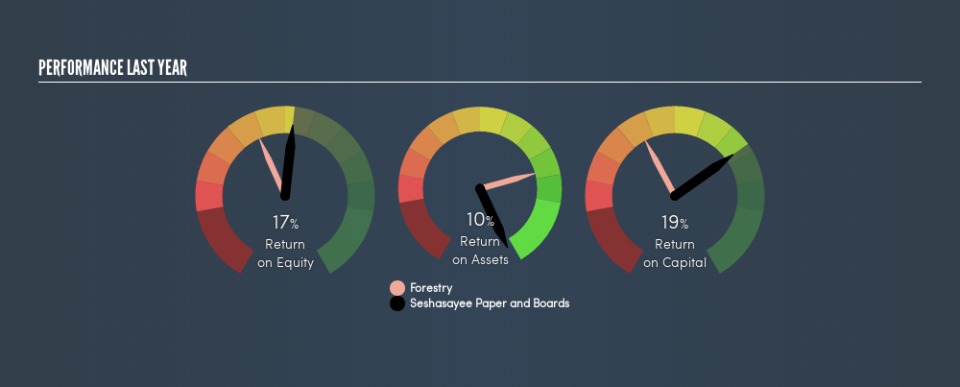What Can We Learn From Seshasayee Paper and Boards Limited’s (NSE:SESHAPAPER) Investment Returns?

Want to participate in a short research study? Help shape the future of investing tools and receive a $20 prize!
Today we’ll evaluate Seshasayee Paper and Boards Limited (NSE:SESHAPAPER) to determine whether it could have potential as an investment idea. In particular, we’ll consider its Return On Capital Employed (ROCE), as that can give us insight into how profitably the company is able to employ capital in its business.
First up, we’ll look at what ROCE is and how we calculate it. Then we’ll compare its ROCE to similar companies. And finally, we’ll look at how its current liabilities are impacting its ROCE.
Return On Capital Employed (ROCE): What is it?
ROCE is a metric for evaluating how much pre-tax income (in percentage terms) a company earns on the capital invested in its business. All else being equal, a better business will have a higher ROCE. Overall, it is a valuable metric that has its flaws. Renowned investment researcher Michael Mauboussin has suggested that a high ROCE can indicate that ‘one dollar invested in the company generates value of more than one dollar’.
How Do You Calculate Return On Capital Employed?
The formula for calculating the return on capital employed is:
Return on Capital Employed = Earnings Before Interest and Tax (EBIT) ÷ (Total Assets – Current Liabilities)
Or for Seshasayee Paper and Boards:
0.19 = ₹1.8b ÷ (₹13b – ₹3.3b) (Based on the trailing twelve months to March 2018.)
So, Seshasayee Paper and Boards has an ROCE of 19%.
Check out our latest analysis for Seshasayee Paper and Boards
Is Seshasayee Paper and Boards’s ROCE Good?
ROCE can be useful when making comparisons, such as between similar companies. We can see Seshasayee Paper and Boards’s ROCE is around the 16% average reported by the Forestry industry. Independently of how Seshasayee Paper and Boards compares to its industry, its ROCE in absolute terms appears decent, and the company may be worthy of closer investigation.
In our analysis, Seshasayee Paper and Boards’s ROCE appears to be 19%, compared to 3 years ago, when its ROCE was 8.6%. This makes us think about whether the company has been reinvesting shrewdly.
When considering this metric, keep in mind that it is backwards looking, and not necessarily predictive. Companies in cyclical industries can be difficult to understand using ROCE, as returns typically look high during boom times, and low during busts. This is because ROCE only looks at one year, instead of considering returns across a whole cycle. Future performance is what matters, and you can see analyst predictions in our free report on analyst forecasts for the company.
Seshasayee Paper and Boards’s Current Liabilities And Their Impact On Its ROCE
Current liabilities are short term bills and invoices that need to be paid in 12 months or less. The ROCE equation subtracts current liabilities from capital employed, so a company with a lot of current liabilities appears to have less capital employed, and a higher ROCE than otherwise. To counteract this, we check if a company has high current liabilities, relative to its total assets.
Seshasayee Paper and Boards has total assets of ₹13b and current liabilities of ₹3.3b. As a result, its current liabilities are equal to approximately 26% of its total assets. A fairly low level of current liabilities is not influencing the ROCE too much.
What We Can Learn From Seshasayee Paper and Boards’s ROCE
With that in mind, Seshasayee Paper and Boards’s ROCE appears pretty good. You might be able to find a better buy than Seshasayee Paper and Boards. If you want a selection of possible winners, check out this free list of interesting companies that trade on a P/E below 20 (but have proven they can grow earnings).
I will like Seshasayee Paper and Boards better if I see some big insider buys. While we wait, check out this free list of growing companies with considerable, recent, insider buying.
We aim to bring you long-term focused research analysis driven by fundamental data. Note that our analysis may not factor in the latest price-sensitive company announcements or qualitative material.
If you spot an error that warrants correction, please contact the editor at editorial-team@simplywallst.com. This article by Simply Wall St is general in nature. It does not constitute a recommendation to buy or sell any stock, and does not take account of your objectives, or your financial situation. Simply Wall St has no position in the stocks mentioned. Thank you for reading.

